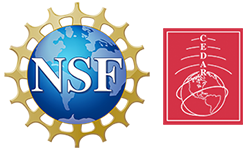2025 Workshop: Traveling Ionospheric Disturbances (TIDs)
Meghan Burleigh
Pavel Inchin
Steve Kaeppler
Kate Zawdie
Dev Joshi
Traveling ionospheric disturbances (TIDs) are quasi-periodic variations in the Earth's ionosphere that propagate horizontally across large distances. They are commonly observed in the upper atmosphere across at all latitudes, local times, seasons, and levels of solar activity. These disturbances are often caused by gravity waves originating from a variety of sources, such as solar and geomagnetic activity, lower atmospheric weather patterns, seismic activity, and more. Despite sharing similar observational signatures, TIDs stem from diverse generation mechanisms, resulting in varied characteristics even when originating from the same source. The focus of this workshop is to understand the distinct TID generation mechanisms and their consequential effects through discussions on the observation and modeling of TIDs, with a particular focus on leveraging multi-instrument observational approaches. We aim to gain insights into the impacts from the Perkins instability and sporadic E phenomena as well as explore the influence of TIDs on the ionospheric-thermospheric (I-T) system as a whole and potential implications for operational systems, such as high-frequency (HF) propagation.
- 1600-1613 Erich Becker “Mountain waves over the western US in January 2017: Higher-order gravity wave generation and thermosphere-ionosphere disturbances”
- 1613-1626 Matt Hogan “Modeling Sporadic-E Formation using a Gravity-wave Resolving Model”
- 1626-1639 Katelyn Youngjohn “Interhemispheric asymmetries in large-scale traveling ionospheric disturbances during the 5-6 August 2011 geomagnetic storm.”
- 1639 -1652 Purbita Chatterjee “Traveling Ionospheric Disturbance (TID) Detection using Deep Learning Models”
- 1652-1705 Asti Bhatt
- 1705-1718 Sophie Phillips “Overlapping MSTAD/MSTID Observations in SDI and ISR over Alaska”
- 1718-1731 John Meriwether “Vertical Wind observations over New Jersey”
- 1731-1744 Sharon Vadas “The cross polar propagation of traveling ionospheric disturbances generated by atmospheric gravity waves from the polar vortex, orographic forcing, deep convection and the Tonga volcanic eruption”
- 1744-1757 Nathaniel Frissell “MSTID and LSTID Response to the Polar Vortex and Gravity Waves in the Northern and Southern Hemispheres”
Join Zoom Meeting
https://clemson.zoom.us/j/98773973964?pwd=xI6aZGZpER3agbW1RgOWhUcRISDN7l.1
Meeting ID: 987 7397 3964
Passcode: 721953
As mentioned above, TIDs are ubiquitous in the ionosphere yet there remains considerable uncertainty regarding their origin and influence. TIDs have often been characterized simply by their time of occurrence (night vs day) yet this does not differentiate their generation mechanisms. A recent International Space Science Institute (ISSI) working group highlighted numerous gaps in our understanding of TIDs. Their generation mechanisms, relative importance of different drivers in their generation, spatial variability, and categorization are all areas that need further investigation. In order to better understand TIDs, efforts must be directed towards discerning their generation mechanisms through both observations and modeling.
